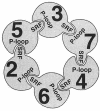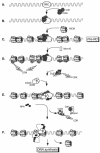Eukaryotic MCM proteins: beyond replication initiation
- PMID: 15007098
- PMCID: PMC362110
- DOI: 10.1128/MMBR.68.1.109-131.2004
Eukaryotic MCM proteins: beyond replication initiation
Abstract
The minichromosome maintenance (or MCM) protein family is composed of six related proteins that are conserved in all eukaryotes. They were first identified by genetic screens in yeast and subsequently analyzed in other experimental systems using molecular and biochemical methods. Early data led to the identification of MCMs as central players in the initiation of DNA replication. More recent studies have shown that MCM proteins also function in replication elongation, probably as a DNA helicase. This is consistent with structural analysis showing that the proteins interact together in a heterohexameric ring. However, MCMs are strikingly abundant and far exceed the stoichiometry of replication origins; they are widely distributed on unreplicated chromatin. Analysis of mcm mutant phenotypes and interactions with other factors have now implicated the MCM proteins in other chromosome transactions including damage response, transcription, and chromatin structure. These experiments indicate that the MCMs are central players in many aspects of genome stability.
Figures





References
-
- Abe, E., K. Kuwahara, M. Yoshida, M. Suzuki, H. Terasaki, Y. Matsuo, E. I. Takahashi, and N. Sakaguchi. 2000. Structure, expression, and chromosomal localization of the human gene encoding a germinal center-associated nuclear protein (GANP) that associates with MCM3 involved in the initiation of DNA replication. Gene 255:219-227. - PubMed
-
- Adachi, Y., J. Usukura, and M. Yanagida. 1997. A globular complex formation by Nda1 and the other five members of the MCM protein family in fission yeast. Genes Cells 2:467-479. - PubMed
-
- Aparicio, O. M., D. M. Weinstein, and S. P. Bell. 1997. Components and dynamics of DNA replication complexes in S. cerevisiae: Redistribution of MCM proteins and Cdc45p during S phase. Cell 91:59-69. - PubMed
Publication types
MeSH terms
Substances
Grants and funding
LinkOut - more resources
Full Text Sources
Other Literature Sources
Molecular Biology Databases

